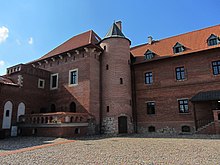Building in Tykocin, Poland
| Tykocin Royal Castle | |
|---|---|
 | |
| General information | |
| Architectural style | Gothic Revival |
| Town or city | Tykocin |
| Country | Poland |
| Construction started | 1433 |
| Demolished | 1734, 1771 |
| Client | Jonas Goštautas |
The Tykocin Royal Castle is a 15th-century castle located on the right bank of the river Narew in Tykocin, Poland. It fell into ruin in the 18th century and its reconstruction began in 2002.
History

The castle – then located on a border area in the Grand Duchy of Lithuania – was built in 1433 for Lithuanian noble Jonas Goštautas, voivode of Trakai and Vilnius, replacing the original wooden fortress. In the 1560s, upon the death of the last member of the Goštautas family the castle became the property of King Sigismund II Augustus, who expanded it. The construction was supervised by Hiob Bretfus, military engineer and royal architect. During the reign of Sigismund Augustus the structure served as a royal residence with an impressive treasury and library as well as the main arsenal of the crown. In 1611–1632 the castle was rebuilt again and surrounded with bastion fortifications by Krzysztof Wiesiołowski, starosta of Tykocin.
During the 1655 Deluge, the Radziwiłł army occupied the castle. On 31 December, 1655, when the castle was besieged by troops of the Tyszowce Confederation, Janusz Radziwiłł, one of the most powerful people in the Polish–Lithuanian Commonwealth considered by some as the traitor, died here. Ultimately, the castle was captured on 27 January, 1657.
In the following years the castle and surrounding lands were donated to Stefan Czarniecki in reward for his contribution in the war. The new owner rebuilt the castle after 1698. In November 1705 the meeting between King Augustus II the Strong and Peter the Great took place here. During this meeting the Order of White Eagle was established by the King of Poland.
In 1734 the castle was destroyed by fire. Since that time, the uninhabited building began to fall into disrepair. In 1771 remains of the castle were destroyed by flood and in 1914, during World War I, the material from the remaining walls was used by the German soldiers to build roads.

Based on the preserved plans of the fortress, found in the archives in Saint Petersburg, the residential part of the castle has been restored (west wing in the style of late Gothic). The original castle was built on a plan of a trapezoid with a courtyard and four cylindrical towers at the corners. The complex was surrounded with fortifications – curtains combined four terrestrial inner bastions.
Treasury
In about 1565 King Sigismund Augustus installed at the castle his private treasury and a collection of books, initially stored at the Vilnius Castle. Sigismund Augustus was a passionate collector of jewels. According to nuncio Bernardo Bongiovanni's relation, his collection was allocated in 16 chests. Among the precious items in his possession was Charles V's ruby of 80 000 scudos' worth, as well as the emperor's diamond medal with Habsburgs Eagle on one side and two columns with a sign Plus Ultra on the other side. He had also a sultan's sword of 16 000 ducats' worth, 30 precious horse trappings and 20 different private-use armours. The papal nuncio wrote in his diary I also saw twenty suits of royal armour of which four were of most wondrous workmanship, namely with a beautiful sculpture and figures set with silver It cost six thousand scudos. The king's possessions included a rich collection of tapestries (360 pieces), commissioned by him in Brussels in the years 1550–1560, which decorated the castle's walls. The king's treasures were scattered after his death.
Gallery
-
 Reconstructed west wing of the castle.
Reconstructed west wing of the castle.
-

-
 Courtyard
Courtyard
-

-

-

-
 Castle restaurant
Castle restaurant
-
 Castle cellars
Castle cellars
-
Hussar armour
-

-
 Cannonbals
Cannonbals
-
See also
References
- "W Tykocinie jest znowu zamek". Gazeta Wyborcza (in Polish). www.zamkipolski.com.pl. 17 December 2004. Archived from the original on 4 February 2011. Retrieved 12 September 2010.
- ^ Michał Lisiński. "Polonica w Szwecji". Polish mementos in Sweden (in Polish). www.zwoje-scrolls.com. Archived from the original on 7 June 2011. Retrieved 12 September 2010.
- ^ Ryszard Rogiński (1990). Zamki i twierdze w Polsce: historia i legendy (Castles and fortresses in Poland: history and legends) (in Polish). Instytut Wydawniczy Związków Zawodowych. p. 113. ISBN 83-202-0796-7.
- ^ Museum in Białystok (1991). "Volume 16". Rocznik białostocki (The Annual of Białystok). Polish Scientific Publishers PWN. p. 75.
- ^ "Ruiny zamku". Ruins of the castle (in Polish). www.tykocin.hg.pl. Retrieved 12 September 2010.
- Jerzy Jan Lerski; Piotr Wróbel; Richard J. Kozicki (1996). Piotr Wróbel; Richard J. Kozicki (eds.). Historical dictionary of Poland, 966–1945. Greenwood Publishing Group. p. 492. ISBN 0-313-26007-9.
- Tadeusz Nowakowski (1974). The Radziwills: the social history of a great European family. Delacorte Press/S. Lawrence. p. 94. ISBN 0-440-07340-5.
- "PNAF Library History". pnaf.us. Retrieved 17 March 2020.
- Tony Sharp (2001). Pleasure and ambition: the life, loves and wars of Augustus the Strong, 1670–1707. I.B.Tauris. p. 223. ISBN 1-86064-619-0.
- ^ Stanisław Cynarski (1988). Zygmunt August (Sigismund Augustus) (in Polish). National Ossoliński Institute. pp. 198–199. ISBN 83-04-02670-8.
- Lech Majewski (2008). Dorota Folga-Januszewska; Lech Majewski; Andrzej Rottermund (eds.). Polish Commonwealth treasures: on the history of Polish collecting from the 13th century to the late 18th. Bosz. p. 111. ISBN 978-83-87730-81-9.
- Tadeusz Wojnowski (1988). A Polish American's guide to Poland. Interpress Publishers. p. 98. ISBN 83-223-1978-9.
External links
- (in Polish) History of the Tykocin Castle
- (in Polish) Treasures of the Polish monarchs
53°12′48″N 22°46′15″E / 53.21333°N 22.77083°E / 53.21333; 22.77083
Categories:
